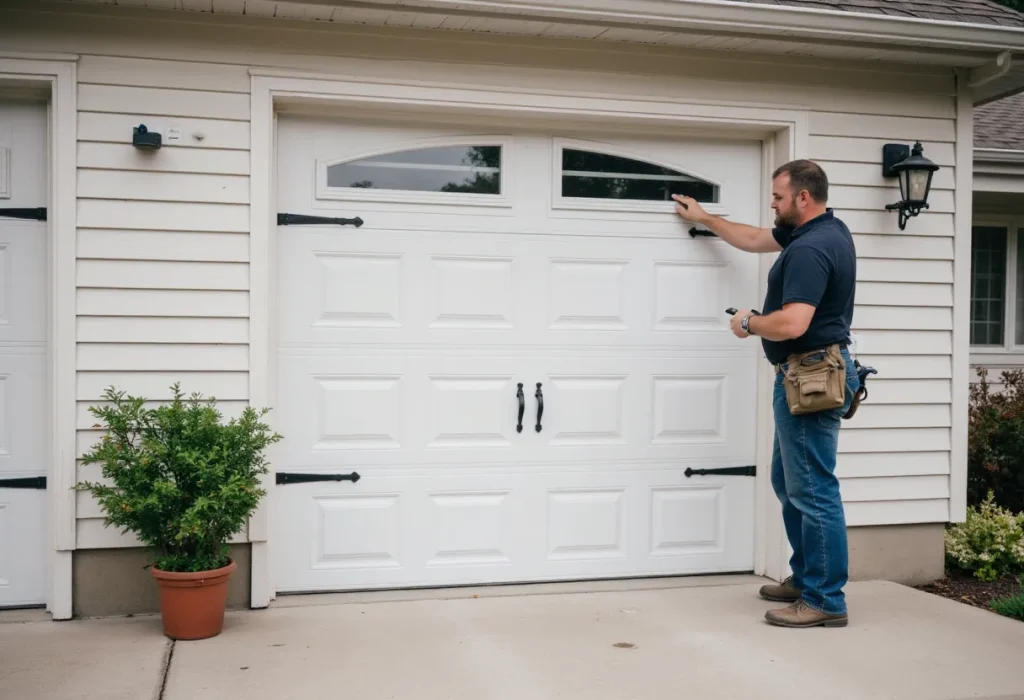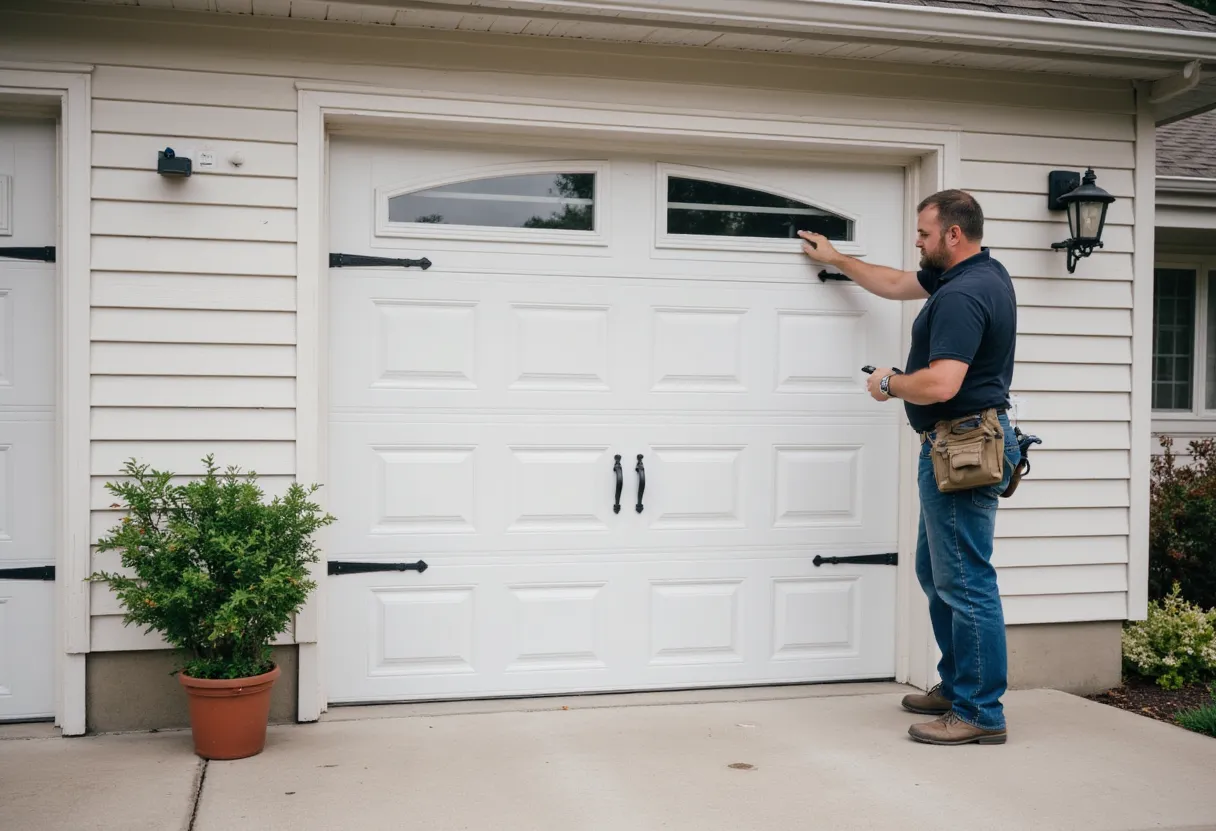Quarterly Garage Door Maintenance
Quarterly Garage Door Maintenance: Essential Tips for Homeowners
Regular maintenance of garage doors is crucial for functionality and safety. Quarterly assessments can prevent costly repairs and enhance the lifespan of the door system. Routine inspections help identify potential issues early, ensuring smooth operation and energy efficiency. This guide covers essential tasks and checks to maintain garage doors effectively.
Regular maintenance of garage doors is crucial for optimal performance and safety. A consistent maintenance routine helps to prevent significant issues that can arise over time.

Importance of Regular Garage Door Maintenance
How Quarterly Maintenance Prevents Costly Repairs
Timely inspections and maintenance of garage doors can greatly reduce the risk of expensive repairs in the future. By identifying minor issues early, homeowners can address them before they escalate. This proactive approach can save money and ensure that the door operates reliably.
- Routine inspections allow for the assessment of wear and tear on various components.
- Addressing small repairs promptly prevents larger systems from failing.
- Regular maintenance schedules can prolong the lifespan of the garage door, reducing the need for replacements.
Safety Benefits of Routine Inspections
Garage doors with malfunctioning components can pose significant hazards. Regular maintenance helps ensure that safety features are functioning correctly. This is especially vital in households with children or pets, as faulty doors can lead to accidents.
- The auto-reverse mechanism must be regularly tested to avoid entrapment.
- Inspecting springs and cables for wear helps prevent sudden failures that could result in injury.
- Ensuring sensors are aligned and operational reduces the risk of accidents during operation.
Impact on Energy Efficiency and Home Protection
A well-maintained garage door contributes to the overall energy efficiency of a home. Issues like gaps in seals or misaligned panels can lead to heated or cooled air escaping, which increases energy bills.
- Properly sealed garage doors keep the home’s climate controlled.
- A well-functioning door can improve insulation, keeping the garage—and consequently the house—more energy-efficient.
- Regular maintenance also protects the garage and home from external elements, such as moisture or debris.
Quarterly Garage Door Inspection Checklist
A thorough inspection of a garage door is vital to ensure its proper functioning and safety. Below are key components to check during the quarterly inspection.
Visual Inspection of Door Panels and Hardware
Begin by visually assessing the entire door, as well as its hardware components. Any signs of damage or wear may indicate the need for repairs or replacements.
Checking for Damage and Wear on Panels
Inspect the door panels for cracks, dents, or any signs of deterioration. Look closely for rust spots or uneven surfaces that might affect the structural integrity of the door. Damaged panels can lead to further long-term issues, including insulation problems.
Inspecting Hinges, Screws, and Bolts
Next, examine the hinges, screws, and bolts to ensure they are secure. Look for rust or corrosion which can weaken these components. Tightening any loose screws or bolts can significantly enhance the door’s operation.
Assessing Door Balance and Springs
Understanding the balance of the garage door and the condition of its springs is essential for safe operation. An unbalanced door can lead to increased wear on the opener and components.
Testing Door Balance Manually
To check the door balance, disconnect the opener and manually lift the door halfway. If it stays in position, the door is balanced. If it rises or falls, the springs may require adjustment.
Recognizing Signs of Worn Torsion Springs
Inspect the torsion springs for any visible signs of wear, such as stretching or breaking strands. If there are issues, replace the springs promptly, as they are under significant tension and can be dangerous to handle.
Evaluating Rollers and Tracks
Assessing the rollers and tracks is crucial for smooth operation. If these components are compromised, the door may operate inefficiently or not at all.
Identifying Worn Out or Damaged Rollers
Check each roller for signs of damage or heavy wear. Look for cracks, chips, or missing material. Replacing worn rollers can prevent future track misalignment and ensure the door closes securely.
Cleaning and Inspecting Garage Door Tracks
Cleaning the tracks is a necessary step in maintaining functionality. Remove dirt, debris, and any obstructions that may impede the door’s movement. Ensure the tracks are aligned and free of bent sections, which could hinder performance.
Lubrication of Moving Parts for Smooth Operation
Proper lubrication is crucial for the efficient operation of garage doors. Ensuring that moving parts are well lubricated not only improves performance but also minimizes wear and tear, ultimately prolonging the life of the door system.
Recommended Lubricants: Silicone Based vs. White Lithium Grease
Choosing the right lubricant can make a significant difference in the maintenance of garage doors. Silicone-based lubricants are generally recommended for their ability to repel moisture and prevent rust, making them ideal for humid environments like South Florida. White lithium grease, on the other hand, provides a thicker layer of protection and is suitable for heavy-duty applications.
- Silicone-based lubricants are ideal for:
- Resisting moisture.
- Reducing friction and enhancing movement.
- White lithium grease is preferable for:
- High-load applications that require heavy-duty lubrication.
- Ensuring long-lasting protection against wear.
How to Properly Lubricate Rollers, Hinges, and Springs
To maximize the effectiveness of lubrication, it is essential to follow specific steps when applying lubricant to key components. Begin by cleaning the parts to remove any dirt or debris that may have accumulated. Then, apply the lubricant carefully to ensure even distribution.
- Rollers:
- Apply a small amount of lubricant directly onto each roller.
- Hinges:
- Put lubricant on the hinges to facilitate smooth opening and closing.
- Springs:
- Lubricate the springs to prevent rust and reduce friction.
Avoiding Common Lubrication Mistakes
Mistakes in lubrication can lead to ineffective maintenance, ultimately compromising the garage door system. Some common pitfalls include over-applying lubricant, using the wrong type of lubricant, and neglecting to clean components beforehand.
- Over-application can attract dirt and cause buildup.
- Using lubricants not suited for garage doors may lead to ineffective protection.
- Failing to clean moving parts can result in poor lubrication and increased wear.
Testing and Maintaining Garage Door Openers
Regular evaluation of garage door openers is critical to ensure reliable operation and safety. This involves multiple testing procedures and maintenance checks to identify potential issues before they escalate.
Manual Operation and Disconnection Procedures
Understanding how to manually operate the garage door opener is essential, especially during power outages or malfunction scenarios. To perform this operation, the opener should be disconnected from the power supply.
Typically, this is done by pulling the emergency release cord, which disengages the opener from the garage door. Once disconnected, the door can be lifted manually. This allows for an opportunity to check the operation and balance of the door. Observing the door’s smooth movement during manual operation is a good indicator of its overall condition.
Checking Safety Features: Auto-Reverse and Photoelectric Sensors
Safety features are integral to modern garage door systems. Regular testing of these features guarantees safe operation for all users.
How to Test Auto-Reverse Function
To ensure the auto-reverse function is working correctly, a simple test can be conducted. Place an object, such as a small piece of wood, in the door’s path. As the door closes, it should reverse direction upon hitting the object. If it fails to reverse, immediate inspection and repair are necessary to uphold safety standards.
Aligning and Cleaning Safety Sensors
Over time, safety sensors may become misaligned or obstructed by debris. To check alignment, inspect each sensor located at the base of the door tracks. The sensors should face each other directly. Any misalignment could prevent proper function.
Cleaning the sensors is equally important. Dust, dirt, or spider webs can obstruct the sensor’s beam. Gently wipe the sensor lens with a soft cloth to ensure a clear path for the safety beam.
Addressing Unusual Noises and Opener Issues
Noises during operation can signal underlying problems requiring attention. Typical sounds may include grinding, squeaking, or clicking. Each of these noises can point to different issues such as lack of lubrication, worn-out components, or operational errors.
For grinding noises, examining the rollers and other moving parts for wear can be revealing. Squeaking often indicates the need for lubrication. Lastly, a clicking sound might suggest a problem with the opener itself, potentially necessitating a professional assessment to ensure the system’s integrity.
Maintaining the garage door opener is essential for safety and reliability. Regular inspections and prompt attention to unusual sounds can enhance the performance and lifespan of garage door systems.
Identifying and troubleshooting garage door problems is crucial for maintaining safety and convenience. Recognizing issues early can prevent more extensive damage and costly repairs.
Identifying and Troubleshooting Common Garage Door Problems
Signs of Wear and Tear on Garage Door Components
Regular inspection of the garage door components can reveal signs of wear that could compromise its functionality. Key indicators include:
- Visible rust or corrosion on metal parts.
- Cracks or warping in door panels.
- Difficulty in opening or closing the door smoothly.
- Noisy operation, especially during movement.
Such signs, if not addressed promptly, can lead to more significant issues, including complete door failure. Checking the condition of the materials regularly helps ensure longevity and reliability.
Recognizing Hardware Looseness and Malfunction
Hardware looseness is another common problem that can affect the performance of a garage door. Common signs include:
- Hinges that appear to be misaligned or loose.
- Screws and bolts that are missing or not tightened.
- Excessive vibration or movement when the door is operated.
Each of these issues requires immediate attention to prevent additional damage. Tightening loose hardware not only improves the door’s operational integrity but also enhances safety for users.
When to Call for Professional Garage Door Repair
While minor issues can often be resolved by homeowners, some problems necessitate professional intervention. It is advisable to seek expert help in the following scenarios:
- When torsion springs exhibit signs of wear or damage, which can be dangerous to handle without proper training.
- If the door becomes completely unresponsive to the opener or manual operation.
- When there are persistent unusual noises, indicating a more profound mechanical issue.
Professional technicians have the necessary tools and expertise to assess and resolve complex problems efficiently, ensuring safe and effective repairs.
Creating an Effective Maintenance Schedule
Establishing a well-organized maintenance schedule ensures that garage doors function optimally while mitigating potential issues before they escalate. By following structured routines, homeowners can ensure both the safety and longevity of their garage doors.
Benefits of Quarterly vs. Annual Professional Services
Quarterly maintenance is highly recommended compared to simply relying on annual inspections. Regular checks significantly reduce the chances of emergency repairs and major malfunctions. Some advantages of quarterly services include:
- Early detection of wear and tear, preventing costly repairs.
- Increased safety by ensuring all components, such as safety sensors and auto-reverse systems, are functioning correctly.
- Better energy efficiency, as properly maintained doors can minimize energy loss.
Annual services may be beneficial for comprehensive inspections, but they should complement, not replace, regular quarterly check-ups. This blend ensures persistent performance and reliability in garage door operations.
Tasks You Can Handle and When to Hire Technicians
Homeowners can take on many routine maintenance tasks, such as:
- Lubricating moving parts every few months.
- Performing visual inspections for damages or wear.
- Cleaning garage door tracks and ensuring they are clear of obstructions.
However, certain tasks, particularly those involving high-tension components such as springs and cables, require a professional’s expertise. It is advisable to call in qualified technicians when:
- Experiencing unusual noises that could indicate deeper issues.
- Noticing difficulty in the door’s automatic operation.
- Identifying potential safety hazards that may arise from malfunctioning parts.
How a Regular Service Helps Prevent Emergency Repairs
Consistent maintenance significantly reduces the likelihood of experiencing unexpected breakdowns. Regularly scheduled check-ups facilitate proactive identification of potential problems, allowing for timely interventions. Key strategies include:
- Keeping a detailed log of maintenance activities to track when services were last performed.
- Setting reminders for regular inspections to ensure they are not overlooked.
- Staying informed about common signs of wear that could precede serious issues.
A diligent approach to maintenance not only enhances operational efficiency but also aids in safeguarding the investment in garage doors, yielding peace of mind for homeowners.
Safety Precautions for DIY Maintenance Tasks
Taking safety precautions during DIY maintenance tasks for garage doors is crucial. Proper handling of components and the right tools can prevent injuries and ensure effective maintenance.
Handling Springs and Other High-Tension Components
Garage door springs are under extreme tension. Mishandling them can lead to serious injuries. Always approach tasks involving springs with caution. Specific measures include:
- Never attempt to adjust or replace springs without professional assistance. Only skilled technicians should handle these components.
- Use appropriate tools designed for high-tension tasks, ensuring a secure grip and proper control.
- Always wear safety goggles to protect your eyes from potential snapping springs.
Proper Use of Tools and Personal Protective Equipment
Using the right tools is essential for safe garage door maintenance. Improper or damaged tools can lead to accidents. Adhering to safety protocols includes:
- Always use well-maintained tools that are appropriate for the job, such as wrenches, screwdrivers, and pliers.
- Equip personal protective gear including gloves, safety glasses, and steel-toed boots to safeguard against injuries.
- Never use electrical tools in wet conditions to avoid electrocution.
When Maintenance Can Be Dangerous and Requires Experts
Not all maintenance tasks are suitable for DIY enthusiasts, especially those involving complex mechanisms. Recognizing situations that necessitate professional intervention includes:
- Struggling with balancing or adjusting springs and cables should prompt a call to a technician.
- Unusual noises during operation may indicate more serious issues that are best handled by experts.
- When there is any uncertainty about safety or repair methods, reaching out to qualified professionals is a wise decision.
Specialized Considerations for South Florida Garage Doors
When maintaining garage doors in South Florida, unique environmental factors must be considered. The specific conditions in the region require tailored approaches to ensure doors function effectively and remain durable.
Maintaining Doors with HVHZ and Wind-Load Standards
Homes in South Florida need garage doors that comply with High Velocity Hurricane Zone (HVHZ) codes. These standards are critical for hurricane-prone areas to withstand strong winds and flying debris. Regularly assessing the garage door for adherence to these requirements is essential.
- Inspect for structural integrity and reinforcement.
- Consider heavy-duty hardware and materials designed for wind resistance.
- Ensure that the door seals tightly to minimize water intrusion.
Upgrading to hurricane-rated doors not only offers protection but may also lower insurance premiums.
Dealing with Humidity and Corrosion in Coastal Environments
The high humidity levels and salt air in coastal areas significantly increase the risk of corrosion. Proper maintenance is imperative in mitigating these effects. Homeowners should focus on:
- Applying corrosion-resistant finishes to metal parts.
- Regularly cleaning the door and its components to remove salt deposits.
- Using high-quality lubricants designed to resist moisture.
Monitoring for rust or corrosion should be a bi-monthly task to ensure longevity.
Recommended Garage Door Parts and Openers for Miami-Dade Homes
Choosing the right parts enhances not only the functionality but also the safety of garage doors in Miami-Dade. It is advisable to invest in:
- Heavy-duty torsion springs that endure the rigors of frequent use.
- Rollers made with durable, weather-resistant materials.
- Garage door openers equipped with advanced safety features like auto-reverse and photoelectric sensors.
These recommendations support the unique demands of the local climate while ensuring optimal performance. Technicians familiar with South Florida conditions can provide valuable insights into the best options for residents.

